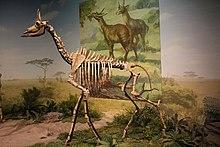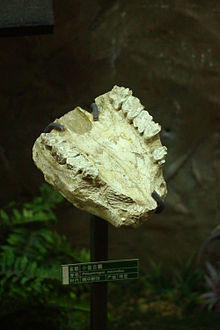| Palaeotragus | |
|---|---|
 | |
| Skeletal mount, Tianjin Natural History Museum | |
| Scientific classification | |
| Kingdom: | Animalia |
| Phylum: | Chordata |
| Class: | Mammalia |
| Order: | Artiodactyla |
| Family: | Giraffidae |
| Genus: | †Palaeotragus Gaudry 1861[1] |
| Species | |
| See text | |
Palaeotragus ("ancient goat") is a genus of very large, primitive, okapi-like giraffids from the Miocene of Africa and Eurasia.
Palaeotragus primaevus is the older species, being found in early to mid-Miocene strata, while P. germaini is found in Late Miocene strata. P. primaevus is distinguished from P. germaini by the lack of ossicones. It was also the smaller species, being a little under 2 m (6 ft 7 in) at the shoulders. P. germaini had a pair of ossicones, and in life, it would have resembled either a short-necked, 3 m (9.8 ft) tall giraffe, or a gargantuan okapi.
Species
The genus consists of the following species:
- Palaeotragus decipiens
- Palaeotragus germaini
- Palaeotragus microdon
- Palaeotragus primaevus
- Palaeotragus quadricornis
- Palaeotragus. rouenii
References
- ^ Palaeotragus in the Paleobiology Database. Retrieved May 2013.
Further reading
- Gaudry, Albert (1861). "Paléontologie. — Résultats des fouilles entreprises en Grèce sous les auspices de l'Académie". Comptes-rendus de l'Académie des Sciences. 53. Paris. p. 239. OCLC 469002103.
External links
